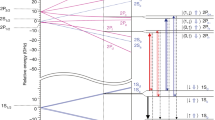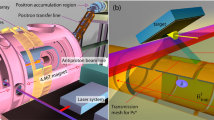Abstract
Antimatter was first predicted1 in 1931, by Dirac. Work with high-energy antiparticles is now commonplace, and anti-electrons are used regularly in the medical technique of positron emission tomography scanning. Antihydrogen, the bound state of an antiproton and a positron, has been produced2,3 at low energies at CERN (the European Organization for Nuclear Research) since 2002. Antihydrogen is of interest for use in a precision test of nature’s fundamental symmetries. The charge conjugation/parity/time reversal (CPT) theorem, a crucial part of the foundation of the standard model of elementary particles and interactions, demands that hydrogen and antihydrogen have the same spectrum. Given the current experimental precision of measurements on the hydrogen atom (about two parts in 1014 for the frequency of the 1s-to-2s transition4), subjecting antihydrogen to rigorous spectroscopic examination would constitute a compelling, model-independent test of CPT. Antihydrogen could also be used to study the gravitational behaviour of antimatter5. However, so far experiments have produced antihydrogen that is not confined, precluding detailed study of its structure. Here we demonstrate trapping of antihydrogen atoms. From the interaction of about 107 antiprotons and 7 × 108 positrons, we observed 38 annihilation events consistent with the controlled release of trapped antihydrogen from our magnetic trap; the measured background is 1.4 ± 1.4 events. This result opens the door to precision measurements on anti-atoms, which can soon be subjected to the same techniques as developed for hydrogen.
This is a preview of subscription content, access via your institution
Access options
Subscribe to this journal
Receive 51 print issues and online access
$199.00 per year
only $3.90 per issue
Buy this article
- Purchase on Springer Link
- Instant access to full article PDF
Prices may be subject to local taxes which are calculated during checkout



Similar content being viewed by others
References
Dirac, P. A. M. Quantised singularities in the electromagnetic field. Proc. R. Soc. Lond. A 133, 60–72 (1931)
Amoretti, M. et al. Production and detection of cold antihydrogen atoms. Nature 419, 456–459 (2002)
Gabrielse, G. et al. Background-free observation of cold antihydrogen with field-ionization analysis of its states. Phys. Rev. Lett. 89, 213401 (2002)
Niering, M. et al. Measurement of the hydrogen 1S-2S transition frequency by phase coherent comparison with a microwave cesium fountain clock. Phys. Rev. Lett. 84, 5496–5499 (2000)
Drobychev, G. Y. et al. Proposal for the AEGIS experiment at the CERN antiproton decelerator (antimatter experiment: gravity, interferometry, spectroscopy). Tech. Report SPSC-P-334; CERN-SPSC-2007–017 (European Organization for Nuclear Research, 2007)
Maury, S. The antiproton decelerator: AD. Hyperfine Interact. 109, 43–52 (1997)
Bertsche, W. et al. A magnetic trap for antihydrogen confinement. Nucl. Instrum. Methods Phys. Res. A 566, 746–756 (2006)
Pritchard, D. E. Cooling neutral atoms in a magnetic trap for precision spectroscopy. Phys. Rev. Lett. 51, 1336–1339 (1983)
Fajans, J. et al. Effects of extreme magnetic quadrupole fields on Penning traps, and the consequences for antihydrogen trapping. Phys. Rev. Lett. 95, 155001 (2005)
Andresen, G. et al. Antimatter plasmas in a multipole trap for antihydrogen. Phys. Rev. Lett. 98, 023402 (2007)
Fujiwara, M. C. et al. Particle physics aspects of antihydrogen studies with ALPHA at CERN. AIP Conf. Proc. 1078, 208–220 (2008)
Gabrielse, G. et al. First capture of antiprotons in a Penning trap: a kiloelectronvolt source. Phys. Rev. Lett. 57, 2504–2507 (1986)
Gabrielse, G. et al. Cooling and slowing of trapped antiprotons below 100 meV. Phys. Rev. Lett. 63, 1360–1363 (1989)
Surko, C. M. & Greaves, R. G. Emerging science and technology of antimatter plasmas and trap-based beams. Phys. Plasmas 11, 2333–2348 (2004)
Jørgensen, L. V. et al. New source of dense, cryogenic positron plasmas. Phys. Rev. Lett. 95, 025002 (2005)
Hess, H. F. Evaporative cooling of magnetically trapped and compressed spin-polarized hydrogen. Phys. Rev. B 34, 3476–3479 (1986)
Andresen, G. B. et al. Evaporative cooling of antiprotons to cryogenic temperatures. Phys. Rev. Lett. 105, 013003 (2010)
Gabrielse, G. et al. Antihydrogen production using trapped plasmas. Phys. Lett. A 129, 38–42 (1988)
Fajans, J., Gilson, E. & Friedland, L. Autoresonant (nonstationary) excitation of the diocotron mode in non-neutral plasmas. Phys. Rev. Lett. 82, 4444–4447 (1999)
Barth, I. et al. Autoresonant transition in the presence of noise and self-fields. Phys. Rev. Lett. 103, 155001 (2009)
Andresen, G. B. et al. Antihydrogen formation dynamics in a multipolar neutral anti-atom trap. Phys. Lett. B 685, 141–145 (2010)
Amoretti, M. et al. Antihydrogen production temperature dependence. Phys. Lett. B 583, 59–67 (2004)
Andresen, G. et al. Search for trapped antihydrogen. Phys. Lett. B. 10.1016/j.physletb.2010.11.004 (in the press)
Huang, X.-P., Anderegg, F., Hollmann, E. M., Driscoll, C. F. & O’Neil, T. M. Steady-state confinement of nonneutral plasmas by rotating electric fields. Phys. Rev. Lett. 78, 875–878 (1997)
Danielson, J. R. & Surko, C. M. Radial compression and torque-balanced steady states of single-component plasmas in Penning-Malmberg traps. Phys. Plasmas 13, 055706 (2006)
Andresen, G. B. et al. Antiproton, positron, and electron imaging with a microchannel plate/phosphor detector. Rev. Sci. Instrum. 80, 123701 (2009)
Andresen, G. B. et al. Compression of antiproton clouds for antihydrogen trapping. Phys. Rev. Lett. 100, 203401 (2008)
Eggleston, D. L., Driscoll, C. F., Beck, B. R., Hyatt, A. W. & Malmberg, J. H. Parallel energy analyzer for pure electron plasma devices. Phys. Fluids B 4, 3432–3439 (1992)
Acknowledgements
This work was supported by CNPq, FINEP/RENAFAE (Brazil); ISF (Israel); MEXT (Japan); FNU (Denmark); VR (Sweden); NSERC, NRC/TRIUMF, AIF, FQRNT (Canada); the DOE and the NSF (USA); and EPSRC, the Royal Society and the Leverhulme Trust (UK). We thank them for their generous support. We are grateful to the Antiproton Decelerator team, T. Eriksson, P. Belochitskii, B. Dupuy, L. Bojtar, C. Oliveira, K. Mikluha and G. Tranquille, for the delivery of a high-quality antiproton beam. The contributions of summer students C. C. Bray, C. Ø. Rasmussen, S. Kemp, K. K. Andersen, D. Wilding, K. Mikkelsen and L. Bryngemark are acknowledged. We would like to thank the following individuals for help: M. Harrison, J. Escallier, A. Marone, M. Anerella, A. Ghosh, B. Parker, G. Ganetis, J. Thornhill, D. Wells, D. Seddon, K. Dahlerup-Pedersen, J. Mourao, T. Fowler, S. Russenschuck, R. De Oliveira, N. Wauquier, J. Hansen, M. Polini, J. M. Geisser, L. Deparis, P. Frichot, J. M. Malzacker, A. Briswalter, P. Moyret, S. Mathot, G. Favre, J. P. Brachet, P. Mésenge, S. Sgobba, A. Cherif, J. Bremer, J. Casas-Cubillos, N. Vauthier, G. Perinic, O. Pirotte, A. Perin, G. Perinic, B. Vullierme, D. Delkaris, N. Veillet, K. Barth, R. Consentino, S. Guido, L. Stewart, M. Malabaila, A. Mongelluzzo, P. Chiggiato, E. Mahner, A. Froton, C. Lasseur, F. Hahn, E. Søndergaard, F. Mikkelsen, W. Carlisle, A. Charman, J. Keller, P. Amaudruz, D. Bishop, R. Bula, K. Langton, P. Vincent, S. Chan, D. Rowbotham, P. Bennet, B. Evans, J.-P. Martin, P. Kowalski, A. Read, T. Willis, J. Kivell, H. Thomas, W. Lai, L. Wasilenko, C. Kolbeck, H. Malik, P. Genoa, L. Posada and R. Funakoshi.
Author information
Authors and Affiliations
Contributions
W.B., P.D.B., J.F., M.C.F., J.S.H., N.M. and D.M.S. conceived, designed and constructed the central ALPHA apparatus and participated in all aspects of the experimental and physics programmes. G.B.A., M.D.A., M.B.-R., E.B., S.C., T.F., A.J.H., R.H., M.J.J., A.P., S.S.e.N. and C.S. participated actively in the experimental runs, data taking, on- and offline analysis, and maintenance and modification of the apparatus. D.R.G., A.O. and J.W.S. contributed to all aspects of the detector systems and participated actively in the experimental and analysis efforts. M.C., D.P.v.d.W. and L.V.J. designed and built the positron accumulator and participated in the experimental programme. F.R. performed the particle simulations reported in this paper, made the theoretical estimate of trapping rate and supported the design and experimental programmes with simulations and calculations. P.N. led the design of the ALPHA silicon detector. P.P. was responsible for implementing the silicon detector at CERN and participated in the experimental and analysis programmes. A.D. and A.G. contributed to the experimental shift work. S.J. and J.S.W. contributed theoretical support in the form of atomic or plasma physics calculations and simulations, and provided guidance in the experimental programme. E.S. contributed to the multichannel plate imaging system and participated in the experimental efforts. C.L.C., W.N.H., M.E.H., S.E., S.M. and R.I.T. participated in the experimental programme and the physics planning effort. Y.Y. provided organizational and financial support and participated in physics discussions. L.K. and K.O. provided off-site support for detector electronics and database management systems, respectively. J.S.H. wrote the initial manuscript, which was edited by J.F., M.C.F., P.D.B., N.M. and E.B. before being improved and approved by the entire collaboration.
Corresponding author
Ethics declarations
Competing interests
The authors declare no competing financial interests.
Rights and permissions
About this article
Cite this article
Andresen, G., Ashkezari, M., Baquero-Ruiz, M. et al. Trapped antihydrogen. Nature 468, 673–676 (2010). https://doi.org/10.1038/nature09610
Received:
Accepted:
Published:
Issue Date:
DOI: https://doi.org/10.1038/nature09610
This article is cited by
-
Nanophotonics for pair production
Nature Communications (2023)
-
Observation of the effect of gravity on the motion of antimatter
Nature (2023)
-
Many-body theory of positron binding to polyatomic molecules
Nature (2022)
-
Antimatter cooled by laser light
Nature (2021)
-
Pulsed production of antihydrogen
Communications Physics (2021)
Comments
By submitting a comment you agree to abide by our Terms and Community Guidelines. If you find something abusive or that does not comply with our terms or guidelines please flag it as inappropriate.



